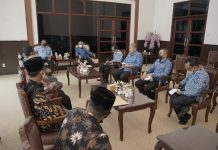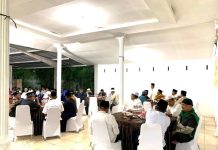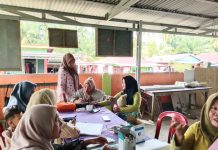In the paintings of Waanyi artist Gordon Hookey, armies of tough kangaroos and other native animals, such as possums, goannas, crocodiles and snakes, represent Australia’s Indigenous peoples. Invasive species such as cane toads and camels, meanwhile, “represent the ugliness of invasive peoples to our lands, country and culture”.
The 61-year-old’s art is funnier than that might suggest and startling in its rowdy satire. Politicians are pigs in his paintings, which tend to be visual commentaries on land rights, deaths in custody and environmental degradation. English, to Hookey, is the colonisers’ language, and he takes liberties on his canvases with playful puns and misspellings: “terrorists” become “terra-ists”, invoking the colonial myth that Australia was an unspoiled terra nullius, or land belonging to no one.
“I don’t take my art seriously at all,” he says. “I have fun with it. I play. I’m silly.”
A MURRIALITY, on display in UNSW Galleries. Photograph: Jacquie Manning
Is anger ever a factor in his work? “Anger could destroy you from within,” he says. “I do feel anger, but that somehow morphs into passion. People can interpret passion and intensity of feeling as anger. But when you feel strongly about something, you’re able to articulate in a particular way.”
Genial and smiling, often bellowing with laughter, Hookey talks loudly – a legacy of apprenticing for four years as an industrial bricklayer from the age 16, cutting bricks amid the deafening concentrators and smelters of the Mount Isa mines. Much of his hearing “has been degraded over time” he says, meaning he struggles to hear higher frequencies. When his sons Josh, 11, and Leon, nine, speak to him, he often replies with “ay?”
Hookey’s Poohtin at UNSW Galleries. Photograph: Jacquie Manning
In his first career survey, A MURRIALITY, which is currently showing at UNSW Galleries and touring nationally in 2023, Hookey’s concerns have gone global. He worries that Australia will follow the US lead and allow rightwing zealotry to flourish. The survey includes a series of new works designed to look like protest banners; on one, Fox pundit “Tukka Cullsin” and “Don the Con” share a can of Kremlin Condensed KGB Shit, which resembles Campbell’s soup.
“The reason why I’m doing all these works about Trump is because it’s so unjust a bullshit artist is believed by so many people,” says Hookey. To him, Maga means “Most Abhorrently Gullible Americans” and the “abhorrent things” they were saying during Trump’s presidency, he says, changed conservative Australian politicians’ way of speaking.
Sacred nation, scared nation, indoctrination
2003. Photograph: Jacquie Manning
“You know how Tanya Plibersek called Peter Dutton Voldemort?” he says. “The true Voldemort is Rupert Murdoch. He who cannot be named – if you can’t be named, you can’t be responsible for the genesis of the harm that you’ve done through your propaganda.”
Born in 1961 in Cloncurry to a single teenage Waanyi mother, Rose, who also had Chinese and Javanese ancestry, Hookey was raised by his aunt Flo from the age of two. Both women have since passed away. His childhood was happy, if impoverished, growing up in corrugated iron humpies and tents in a fringe camp up the hill from Coppermine Creek, in north-west Queensland.
Hoogah Boogah, 2005. Photograph: Jacquie Manning
“The bush, the creeks, the spinifex, that was my playground,” Hookey recalls, sitting in the gallery of the University of New South Wales’ School of Art and Design in Paddington, where he studied in the 1980s, and where A MURRIALITY has just opened. “We had ultimate freedom.”
Sign up to receive Guardian Australia’s weekend culture and lifestyle email
Various uncles, many of them stockmen who brought back stories from their travels, were his father figures: he recalls his Uncle “Chonk”, Johnny Samarden, gathering the children and drawing figures in the dirt, casting Hookey and his cousins as superheroes in his stories. In these tales, the children had M16s slung over their shoulders and were dodging mortar shrapnel; these yarns were spun from the Vietnam war bulletins constantly broadcast on the radio that was always on.
Does he know anything about his dad? “I know of his name, but my mum said not to contact him, simply because she was afraid that I would get hurt … because he was a white man with a family and obviously – maybe – he was just using mum for that one night.”
Aboriginality victorious, 2008. Photograph: Jacquie Manning
When I ask Hookey about the Albanese government’s commitment to a referendum for a constitutionally enshrined Indigenous Voice to Parliament, it prompts a deeply personal response about the practical issue of housing.
“I don’t know,” he says. “I’m very sceptical of government … I just wonder how much say community has in government policy. As a single dad that’s been separated from my family, I haven’t really got a place for my little boys to come and stay with me because I can’t find a place on the rental market.” Hookey blames the investment market: “The majority of people in parliament have investment property. There’s no way they’re going to change that because of their own interests.”
A Dot Painting, 2022. Photograph: Jacquie Manning
By day, Hookey continues to paint in a studio shared with other artists, in a former paint factory in Yeronga, south of Brisbane. But later in our interview, Hookey confides in a low voice: “I am struggling. I’m in the studios, I’m on floors, I’m on sofas. I’ve even slept in cars.”
‘I am struggling’ … Hookey at work in the studio. Photograph: Rhett Hammerton/UNSW
Yet his work continues apace. This includes different versions of a mural painting, MURRILAND!, the first of which has been installed at the UNSW Gallery. Hookey was inspired by a series of small paintings by the late Congolese artist Tshibumba Kanda Matulu that told the brutal colonial history of the Congo under Belgium’s King Leopold II. Hookey’s version is a large mural populated by non-chronological scenes in the history of Indigenous Australians: such as 1606, when members of Dutch explorer Willem Janszoon’s crew were attacked by the Wik people on the west coast of Cape York.
This was more than a century and a half before James Cook claimed Australia for Britain, Hookey points out. The Dutch “were shit scared, they squibbed, they fucking put their tails behind the leg and they took off.”
“Australia has a fucking day where we stop for a horse race, right?” he says. “This is a incident we should celebrate – how a First Nations nation drove off a superpower that day.”
The post The rowdy satire of Gordon Hookey: ‘I don’t take my art seriously at all’ first appeared on Eatory.my.id.
















